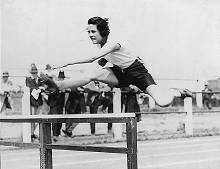Los Angeles Olympics 1932 In 1932 the Olympic Games were held for the second time in America, this time in Los Angeles. In Los Angeles, a hundred and twenty-seven women took part in three sports, swimming, fencing and athletics - one sport less than the Amsterdam Olympics. Women’s gymnastics was not included this time in the programme. A trip to California was a long and expensive journey for many competing nations and there was a significant reduction in the number of competitors, in particular women, who were outnumbered ten to one by the men. For those who did make the trip, like those who went to Amsterdam, it was to prove unforgettable. Dutch swimmer Marie Vierdag: "In 1932 we had a wonderful trip to Los Angeles, by boat from Rotterdam to New York, and by train from coast to coast. The whole trip took two months and we visited all the highlights of the beautiful country." The British team also travelled by ship and went from Southampton. Violet Webb’s eyes shone when she recalled the journey.
Even for an American, the journey was special, as USA swimming gold medallist Helen Johns, World and Olympic record holder in the 4 by 100 metres freestyle relay, discovered: "The Olympic Special train from New York had seventeen cars, one air conditioned and one a gym. We were on board three nights and four days - a great way to see the United States." Javelin thrower Tilly Fleischer was twenty-one when she travelled over with the German team: "We sailed from Bremenhaven to New York with the Europa, at that time the fastest ship in the world. We were met by the mayor, Jimmy Walker. A huge crowd of German-Americans welcomed us in Central Park. We travelled four days and four nights with the Santa Fé to Los Angeles. No-one would do this today - nowadays you can fly in six to eight hours." The competing nations arrived in Los Angeles - a city with a desire to create the best Olympiad ever, but trapped in deep economic depression. Winner’s podium for the first time The Los Angeles Coliseum, built in 1921 and enlarged in 1930 to hold over a hundred thousand spectators, was the main stadium. The running track had a new surface of crushed peat and, for the first time, there appeared a three-tiered victory stand for the medal presentation ceremonies. Many of the winning athletes standing on this podium to receive their medal cite this experience as their most important Olympic memory, one that has always remained with them. Helen Johns the USA gold medalist, enthused: "When we won I felt I had done a small thing to bring honor to the United States. I was overcome with emotion when the USA flag went up and the Star Spangled Banner was played." Violet Webb agreed: "It was wonderful, wonderful. It was an awe-inspiring thing to go and compete in this fabulous stadium that you must have seen in 1984. The opening ceremony was absolutely fabulous. You felt proud, you were British, as you paraded around. The biggest thing, when you see them standing on the rostrum now, with the tears, I can understand how they feel because it was like that for us. When we stood on the rostrum, just the four of us, when the Union Jack went up it is amazing. If you are proud of your country you do feel that way."Australian swimmer, Evelyn de Lacy, later said: "I think the greatest moment in any athlete’s life is to stand on the dais and hear the National Anthem played and watch their country’s flag being raised. I still believe that today." |
